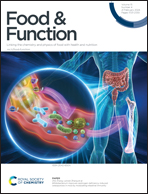Key structural factors and intermolecular interactions underlying the formation, functional properties and behaviour in the gastrointestinal tract in vitro of the liposomal form of nutraceuticals coated with whey proteins and chitosan†
Abstract
The aim of this study was to gain a better understanding of the key structural factors and intermolecular interactions underlying the formation, functionality, and in vitro gastrointestinal behaviour of the liposomal form of nutraceuticals coated with whey proteins (WPI) and chitosan (CHIT). Phosphatidylcholine (PC) liposomes were used to encapsulate a combination of hydrophobic and hydrophilic nutraceuticals. The hydrophobic constituents were long-chain (LC) n-3 PUFAs (DHA and EPA) from fish oil (FO), vitamin D3, and clove essential oil (CEO), while the hydrophilic component was γ-aminobutyric acid (GABA). A combination of physicochemical methods was used to achieve this goal, including electron paramagnetic resonance spectroscopy (EPRS), laser light scattering in dynamic, static, and electrophoretic modes, transmission electron microscopy, spectrophotometry and tensiometry. The efficiency of encapsulating the nutraceuticals in PC liposomes simultaneously was as follows: 100 ± 1% for both FO triglycerides and CEO, 82 ± 2% for vitamin D3, and 50 ± 1% for GABA. According to EPRS data, encapsulating LC PUFA reduced microviscosity at a depth of 20 Å in the PC bilayer. The co-encapsulation of other nutraceuticals in PC liposomes at selected concentrations did not alter this effect. The upper part (8 Å) of PC liposome bilayers showed an increase in rigidity parameter S, indicating the presence of D3, CEO, and partially GABA. The liposome layer-by-layer encapsulation efficiency (EE%) was achieved by using WPI to form the binary complex [WPI-(PC-FO-D3-GABA-CEO)] (EE = 50% at pH 7.0 and I = 0.001 M), followed by coating with chitosan to form the ternary complex [WPI-(PC-FO-D3-GABA-CEO)]-CHIT (EE = 80% at pH 5.1 and I = 0.001 M). The biopolymer-coated liposomes displayed high water solubility owing to their submicron sizes, thermodynamic affinity for the aqueous medium, and 20 mV ζ-potential values. The chitosan shell regulated the release of liposomes from the ternary complex during in vitro gastrointestinal digestion. In the stomach, the hydrolysis of chitosan by pepsin resulted in a 40% release of liposomes. In the small intestine, chitosan was separated from the WPI-liposome core, facilitatig its hydrolysis and resulting in a 60% release of liposomes. The bioavailability of nutraceuticals encapsulated in PC liposomes in the small intestine may be enhanced by the interactions of both non-hydrolysed and hydrolysed liposomes with bile salts and mucin.



 Please wait while we load your content...
Please wait while we load your content...